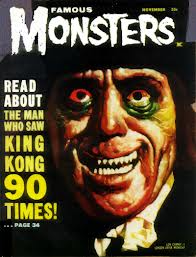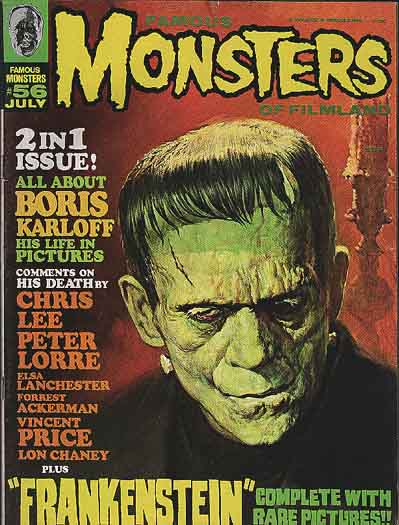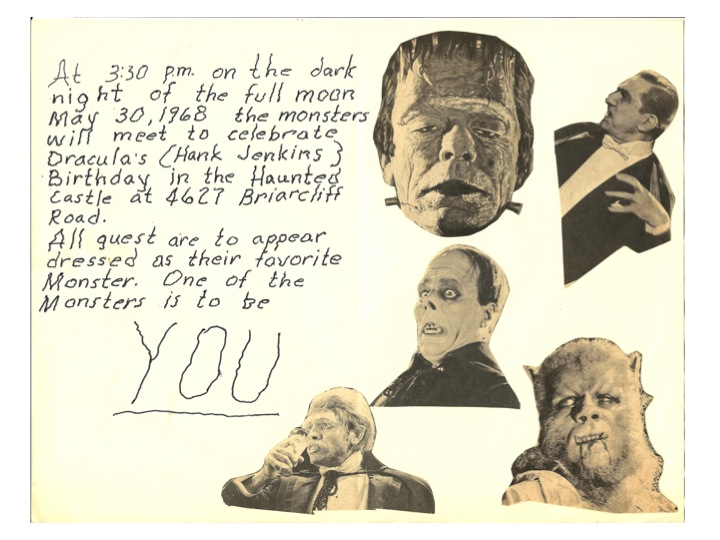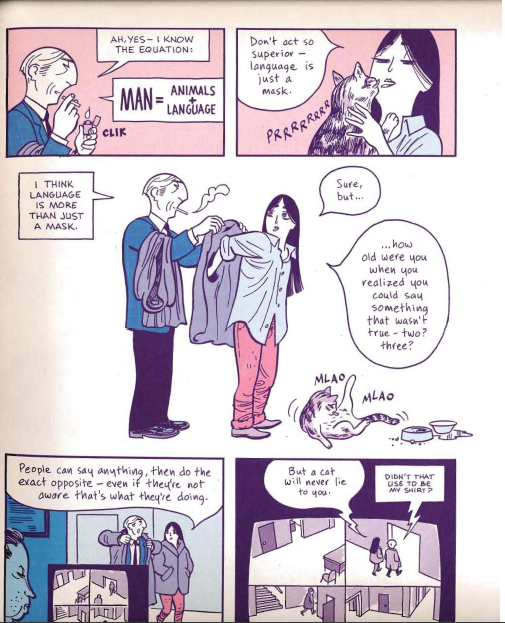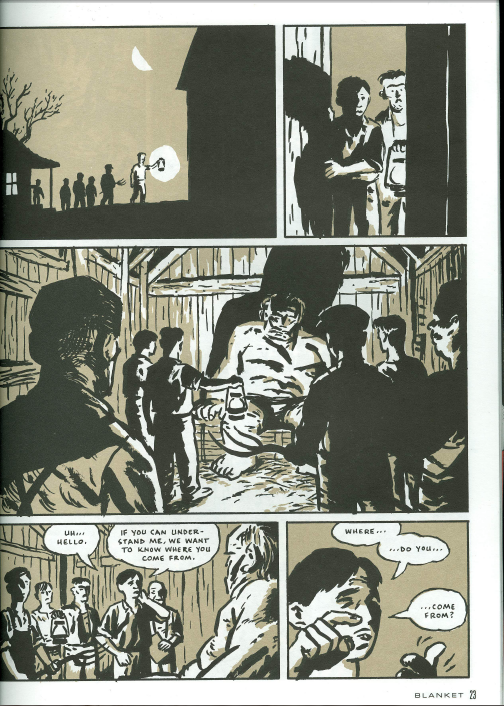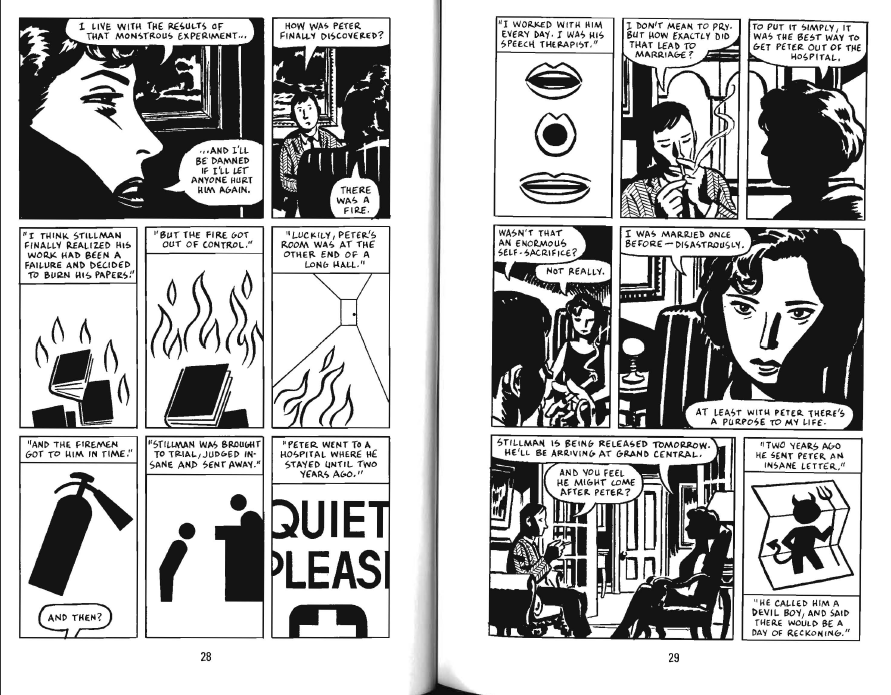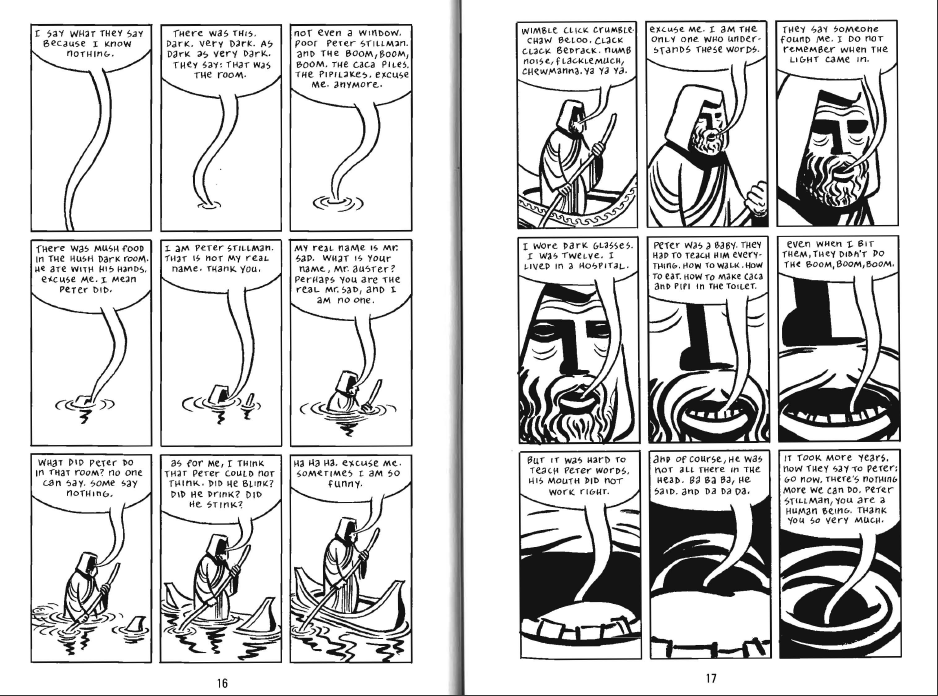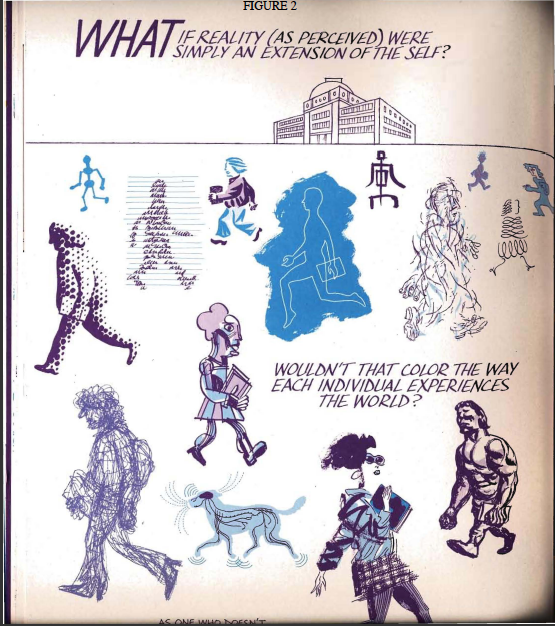Let Us Now Praise Famous Monsters: A Conversation (Part Three)
/Studying Monster fandom places a new emphasis on issues of collecting, which have remained marginal to the studies of fan culture, but which are a very large part of the phenomenon itself. What existing work do you think provides the best insights into collecting cultures and what questions do you think still need to be addressed?
Mark: I think that matters of collecting have been tangential in part because the background so many media scholars have in Marxist /Frankfurt School criticism still makes a lot of us reticent to look at conspicuous consumption as anything other than totally negative--I know I’m leery of being accused of false consciousness or bougie-ness when making a case for collecting as a form of amateur cultural preservation. That said, I’ve been relieved to encounter an increasing number of writings which take a more complicated approach to the consumption of commercial product. I would specifically mention Sara Gwenllian-Jones’s essay “Phantom Menace,” Alan McKee’s “How to Tell the Difference between Production and Consumption,” and Matt Hills’s concept of performative consumption, presented in Fan Cultures, and which I apply to Chaney fans in my essay. I’m also interested in the idea of creative consumption proposed by Jean Burgess and Joshua Green in their book on YouTube, although I wish they would have developed the concept for the reader a little more. I think Jose van Dijck has many interesting ideas about material culture and collecting in Mediated Memories, and I just discovered a book by Richard Cox on the practice of personal archiving that looks promising and is on my reading list. As far as questions that still need to be addressed, I’m interested in distinctions between the physical object and the digital--is downloading digital artifacts collecting in the same sense as “having” tangible objects? There’s been work done in this area in museum studies, which may provide an inroad for looking at this matter in media studies.Bob: A great list, Mark -- I’m making notes! I’d add Baudrillard’s System of Objects and, less abstractly, Jonathan Gray’s Show Sold Separately as ways of understanding collectors and collecting in conversation with mass media marketing. Lincoln Geraghty’s upcoming book with Routledge on “cult collecting” will also be useful, I’m sure.
Matt: As a collector of Silver Age comic books and vinyl records, the issue of collecting is rather personal to me. In terms of questions to pursue re: collecting, I’m particularly interested in issues of commodity value and “collectability” of an object. I have a friend who is intensely proud of his collection of early Silver Age issues of The Justice League of America. They are all of very high grade (virtually untouched warehouse copies in some cases) and are “slabbed.” For him, they retain a nostalgic value (he owned copies as a kid) but he mostly values them as a financial investment. On the other hand, my collecting has always been motivated by a desire to read or listen to something and am much less concerned about condition. In fact, I frequent comic book conventions looking for “reader copies” of old comic books in part because they are much more affordable but also because I’m very interested in objects that bear traces of their use-histories. Usually with comic books this comes in the form of a signature of ownership on the cover or the first page but sometimes there are surprising traces left behind, such as an attached personal object. I once found a nearly incoherent response to a ‘Dear John’ letter tucked inside an LP. It provided a strange resonance to the love songs on the record.
Natasha: As a former product developer who designed collectibles, I am very compelled by this question. I’m shocked there hasn’t been more work done on collectibles in relation to fan studies. Enormous amounts of time, capital and passion are put into collecting. I believe that closely studying the motivations, desires, patterns, and strategies of fan based collectors can provide valuable insights and new ways to think about fan cultures. A couple of edited volumes I’ll add to the list are: Acts of Possession: Collecting in America (ed. Leah Dilworth) and The Cultures of Collecting (ed. Roger Cardinal).
A key claim here is that Famous Monsters and its fans shaped the canon of which older films mattered and also informed the ways we made sense of those movies. What are some of the films or performers that got reappraised thanks to being featured in this publication?
Matt: More than anything, I think FM is notable for spotlighting special effects artists, especially Willis O’Brien and Ray Harryhausen, and make-up artists like Jack Pierce. Ackerman’s narratives regarding individual artists foregrounded the tactile labor involved in filmmaking that inspired so many readers to create their own make-ups and make their own films. The visible traces of these artists translated to the visible traces of the artist(s) of the amateur film.
Mark: Certainly FM played a major role in making Chaney appear intriguing to a generation of monster fans who may have never actually seen any of his films, and in shaping his remembrance as a star of horror films rather than as a more versatile character actor. FM was particularly instrumental in keeping one of Chaney’s lost films, London After Midnight (Browning, 1927), in memory, and of touting it as a masterpiece of horror. Ackerman may have been one of the last surviving people with a clear memory of having seen the film, and he spoke glowingly of it to the end--as he did at a Monster Bash convention Matt and his brother and I attended in 2006. In doing research for this essay, I was also fairly amazed at some of the stills and information found in the pages of FM on obscure, foreign, and/or avant-garde films like Dreyer’s Vampyr, the 1930s French version of The Golem (even now hard to find), and non-western films like Kwaidan.
Ackerman, as several of you note, was an important bridge figure -- between fans and the industry, but also between fandom and a range of other alternative cultural movements, and perhaps between childhood and adulthood. What kind of role model did Ackerman provide for what a mature fan identity might look like?
Matt: Ackerman’s liberal attitudes about life are, I believe, quite relevant to his fannish affections for science fiction. I am particularly intrigued by how certain aspects of his life are very problematic for some fans (in particular his practice of nudism in the 1950s and 1960s). More than anything, Ackerman modelled tolerance and the necessity to think about new ways of living with one another. Interestingly, this model is seemingly lost on some fans, who reduce Ackerman to the status of “grand collector” and nothing more.
Mark: In addition to the inclusivity and progressive perspectives Matt refers to, I think Ackerman also modelled sincerity, generosity, and kindness. One of the things I discovered while looking through old issues of FM was a series of announcements by Ackerman about an upcoming cross-country road trip he was taking, with the offer to readers that if their parents gave permission, he would visit them en route and show them some of the monster memorabilia he had with him. Imagine that! Ackerman also demonstrated a respect for children that is admirable. While I still find his sense of humor hard to take, he seems like he would have been a genuinely nice person to know.
Bob: Actually, it’s Ackerman’s sense of humor that most appealed to me as a kid; it set up a lovely counterpoint to the horrific imagery the magazine often featured, and went a long way toward “defanging” some of the primally upsetting stuff that I was drawn to, but disturbed by, in other formats (cf. the 1974 Exorcist coverage I mention above). In addition to signalling geniality and likeability, as Mark points out, Ackerman’s prose voice also delighted in its own corny panache, and encouraged me -- not always for the better -- to emulate his punning, Mad-magazine-style in my own writing.
Natasha: Ackerman’s quest to promote respect, understanding and acceptance of all people regardless of their gender, race, sexual orientation or age is what I have always admired most about his cultural legacy. Not only was Ackerman a prominent and outspoken supporter of female-produced science- fiction work, but he was also a stanch advocate for gay rights. He was dubbed an honorary lesbian by Daughters of Bilitis, the first lesbian rights organization in the U.S. He believed that monster films and science fiction had the capacity to take viewers out of their comfort zone and imagine alternative realities that could challenge existing sexist, racist, sexist, and ageist thinking. Ackerman had the foresight to know that fan participation is not whimsical and irrelevant, but can be a very powerful thing that can change the way people see and interact with each other. Best of all, he always did this with a sense of humor.
Matt was lucky enough to have had a chance to interview Ackerman before he died. If the rest of us had a chance to ask “Uncle Forry” a question, from beyond the grave (of course), what would you most like to know about his life, his magazine, or its cultural impact?
Mark: I’m curious as to how conscientiously he promoted his social politics in the pages of FM: he absolutely influenced genre fandom and formation of a canon of stars and films, but was he also trying to influence readers’ perspectives? More than asking him specific questions, though, I would’ve really liked to just talk about horror films with him, and get more of that first-hand view of London After Midnight.
The recent film, Super 8, offers some glimpses into the world of amateur filmmaking and model building which Famous Monsters inspired. To what degree do you think the film adequately captured the cultural milieu we are documenting through these essays?
Matt: Super 8 overwhelmed its superficial take on 1970s monster kid culture with sci-fi spectacle. Joe Dante’s Matinee, while not a great film, is more successful at capturing the spirit of horror fandom because it shows us why kids loved this culture. Super 8’s computer-generated spectacle is absent of the trace evidence of an artisan and thus distances us from the affective connections we make with classic horror and science fiction films. In the end, the film’s nod toward kids’ amateur films of the period feels just like that, a nod. There’s nothing substantive behind the title reference to home movies/amateur films or the storyline of the kids making a movie, no clear reason as to why they want to make a monster movie.
Bob: Funny, when I gave a talk based on my article recently, I started with a clip from Super 8: it shows the young protagonist at work painting one of Aurora’s Hunchback of Notre Dame kits. I wanted to contrast the plastic monster’s humble cameo against the movie’s CGI “star,” which was -- and here I agree with Matt -- a dispiriting genuflection to the state of the art. (If only J. J. Abrams and crew had had the guts to give us an actual creature of late 70s special effects -- a Rob Bottin or Carlo Rambaldi creation of latex and servomotors.) Its false notes aside, I respect Super 8 for what it’s trying to do (and be), and in the film’s enshrining of an earlier moment in the evolution of fantastic media -- the late 70s/early 80s golden age of Spielberg and Lucas -- heard curious nested echoes of other, prior golden ages: the late 50s-early 60s monster culture in which Spielberg, Lucas, Cameron, Zemeckis, Dante, and others came of age, as well as the period 20-30 years before that, when the classic Universal horror films were first released. Famous Monsters bridged at least three generations in this fashion, and overgrown “monster kid movies” like Super 8 are to me a way of carrying that tradition forward: revisiting and rearticulating shared, nostalgic pleasures while driving the continued industrial production of fantastic media.
Mark: Super 8 is nostalgic, in the way David Lowenthal uses the term to describe “memory with the pain removed.” There’s an implication that the young filmmakers/adventurers are misfits, or aren’t performing masculinity “correctly,” and that this somehow lends itself to their shared interest in monsters. But even though they’re misfits, they are in a group of friends, and all appear to be in a position of class privilege (except the Elle Fanning character, but she’s the exception in multiple ways). The film doesn’t really address the isolation, loneliness, ostracization, or queerness that has led many a young person to interest in fantasy, monsters, science fiction, role playing games, ancient mythology, the goth subculture, the occult, etc. But of course, isolation, loneliness, and queerness aren’t topics one sees addressed too often in big-budget Hollywood action films.
Mark Hain is a PhD candidate in the Department of Communication and Culture at Indiana University, and is currently working on his dissertation, which is a historical reception study looking at star image and how audiences interpret and find use for these images, with a specific focus on Theda Bara.
Bob Rehak is an Assistant Professor in the Film and Media Studies Program at Swarthmore College. His research interests include special effects and the material practices of fandom.
Natashia Ritsma is a PhD candidate in the Department of Communication and Culture at Indiana University. Her research interests focus on documentary, experimental and educational film and television.
Matt Yockey is an Assistant Professor in the Department of Theater and Film at the University of Toledo. His research interest is on the reception of Hollywood genre films.

